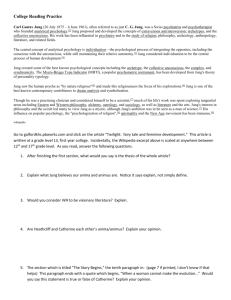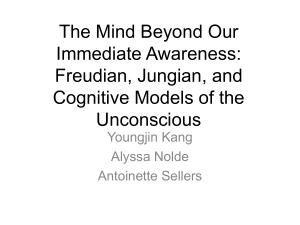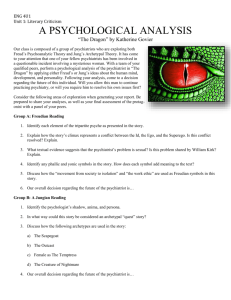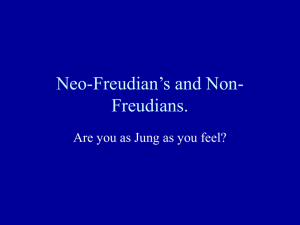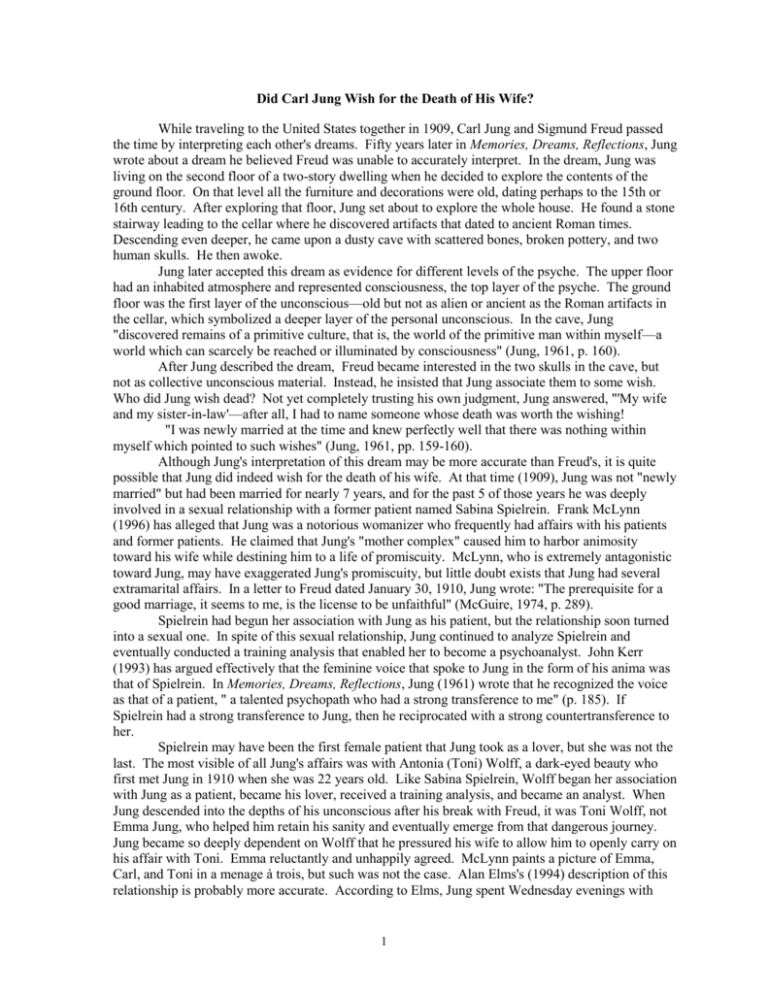
Did Carl Jung Wish for the Death of His Wife?
While traveling to the United States together in 1909, Carl Jung and Sigmund Freud passed
the time by interpreting each other's dreams. Fifty years later in Memories, Dreams, Reflections, Jung
wrote about a dream he believed Freud was unable to accurately interpret. In the dream, Jung was
living on the second floor of a two-story dwelling when he decided to explore the contents of the
ground floor. On that level all the furniture and decorations were old, dating perhaps to the 15th or
16th century. After exploring that floor, Jung set about to explore the whole house. He found a stone
stairway leading to the cellar where he discovered artifacts that dated to ancient Roman times.
Descending even deeper, he came upon a dusty cave with scattered bones, broken pottery, and two
human skulls. He then awoke.
Jung later accepted this dream as evidence for different levels of the psyche. The upper floor
had an inhabited atmosphere and represented consciousness, the top layer of the psyche. The ground
floor was the first layer of the unconscious—old but not as alien or ancient as the Roman artifacts in
the cellar, which symbolized a deeper layer of the personal unconscious. In the cave, Jung
"discovered remains of a primitive culture, that is, the world of the primitive man within myself—a
world which can scarcely be reached or illuminated by consciousness" (Jung, 1961, p. 160).
After Jung described the dream, Freud became interested in the two skulls in the cave, but
not as collective unconscious material. Instead, he insisted that Jung associate them to some wish.
Who did Jung wish dead? Not yet completely trusting his own judgment, Jung answered, "'My wife
and my sister-in-law'—after all, I had to name someone whose death was worth the wishing!
"I was newly married at the time and knew perfectly well that there was nothing within
myself which pointed to such wishes" (Jung, 1961, pp. 159-160).
Although Jung's interpretation of this dream may be more accurate than Freud's, it is quite
possible that Jung did indeed wish for the death of his wife. At that time (1909), Jung was not "newly
married" but had been married for nearly 7 years, and for the past 5 of those years he was deeply
involved in a sexual relationship with a former patient named Sabina Spielrein. Frank McLynn
(1996) has alleged that Jung was a notorious womanizer who frequently had affairs with his patients
and former patients. He claimed that Jung's "mother complex" caused him to harbor animosity
toward his wife while destining him to a life of promiscuity. McLynn, who is extremely antagonistic
toward Jung, may have exaggerated Jung's promiscuity, but little doubt exists that Jung had several
extramarital affairs. In a letter to Freud dated January 30, 1910, Jung wrote: "The prerequisite for a
good marriage, it seems to me, is the license to be unfaithful" (McGuire, 1974, p. 289).
Spielrein had begun her association with Jung as his patient, but the relationship soon turned
into a sexual one. In spite of this sexual relationship, Jung continued to analyze Spielrein and
eventually conducted a training analysis that enabled her to become a psychoanalyst. John Kerr
(1993) has argued effectively that the feminine voice that spoke to Jung in the form of his anima was
that of Spielrein. In Memories, Dreams, Reflections, Jung (1961) wrote that he recognized the voice
as that of a patient, " a talented psychopath who had a strong transference to me" (p. 185). If
Spielrein had a strong transference to Jung, then he reciprocated with a strong countertransference to
her.
Spielrein may have been the first female patient that Jung took as a lover, but she was not the
last. The most visible of all Jung's affairs was with Antonia (Toni) Wolff, a dark-eyed beauty who
first met Jung in 1910 when she was 22 years old. Like Sabina Spielrein, Wolff began her association
with Jung as a patient, became his lover, received a training analysis, and became an analyst. When
Jung descended into the depths of his unconscious after his break with Freud, it was Toni Wolff, not
Emma Jung, who helped him retain his sanity and eventually emerge from that dangerous journey.
Jung became so deeply dependent on Wolff that he pressured his wife to allow him to openly carry on
his affair with Toni. Emma reluctantly and unhappily agreed. McLynn paints a picture of Emma,
Carl, and Toni in a menage à trois, but such was not the case. Alan Elms's (1994) description of this
relationship is probably more accurate. According to Elms, Jung spent Wednesday evenings with
1
Toni, and Toni cane to the Jung household for Sunday dinner with Carl, Emma, and the children, who
were no more pleased than their mother over this arrangement.
Jung and Wolff continued their affair for at least 2 decades and made no attempt to hide the
relationship. Nevertheless, the name Toni Wolff does not appear in Jung's autobiography, Memories,
Dreams, Reflections. Elms discovered that Jung had written a whole chapter on Toni Wolff, a chapter
that was never published. The absence of Toni's name in Jung's autobiography is probably due to the
hatred of Jung's children for Wolff. They remembered when she had carried on openly with their
father, and they harbored some lifelong resentment toward her. As adults with some veto power over
what appeared in their father's posthumously published autobiography, they were not in a generous
mood to perpetuate knowledge of the affair.
By age 60, Toni Wolff had developed arthritis and had lost most of her physical
attractiveness. Three years later, she died, no longer Jung's friend or companion. Jung did not attend
the funeral of the woman who served him as a second wife and rescued him from a severe midlife
crisis.
One final, rather unsavory note on Jung's relationships with women is his claim that Freud
had had an affair with his own sister-in-law Minna Bernays. In 1957, Jung told John Billinsky, an
American psychologist, that at the first meeting between Jung and Freud in Vienna in 1907, Minna
Bernays pulled Jung aside and confessed that she was having an affair with Freud. According to
Billinsky (1969), Jung told him:
Soon I met Freud's wife's younger sister. She was very good-looking and she not
only knew enough about psychoanalysis but also about everything that Freud was
doing. When, a few days later, I was visiting Freud's laboratory, Freud's sister-in-law
asked if she could talk with me. She was very much bothered by her relationship
with Freud and felt guilty about it. From her I learned that Freud was in love with
her and that their relationship was indeed very intimate. It was a shocking discovery
to me, and even now I can recall the agony I felt at the time. (p. 42)
Since Billinsky's article appeared, scholars have debated the validity of Jung's claims. Other
than Jung's story, little evidence exists that Freud was romantically linked to Minna Bernays—or any
woman other than his wife. Although Jung's mind remained clear until his death in 1961, his memory
of Minna's confession was 50 years old. Also, Jung described Minna as "very good-looking."
Beauty, of course, is subjective, but few people would view photographs of Minna Bernays and
pronounce her as "very good-looking." At almost all stages of her life, she was quite plain-looking
and not nearly as pretty as her sister Martha Bernays Freud. In addition, it does not seem likely that
Minna Bernays, having known Jung for only a very short period of time, would have called him aside
and confessed having an affair with Freud. Perhaps Jung's claim that Freud had a sexual relationship
with Minna tells us more about Carl Jung than it does about either Sigmund Freud or Minna Bernays.
References
Billinsky, J. (1969). Jung and Freud. Andover Newton Quarterly, 10, 39-43.
Elms, A. C. (1994). Uncovering lives: The uneasy alliance of biography and psychology. New
York: Oxford University Press.
Jung, C. G. (1961). Memories, dreams, reflections. (A. Jaffe´ Ed.). New York: Random House.
Kerr, J. (1993). A most dangerous method: The story of Jung, Freud, and Sabina Spielrein. New
York: Knopf.
McLynn, F. (1996). Carl Gustav Jung. New York: St Martin's Press.
McGuire, W. (Ed.). (1974). The Freud/Jung letters: The correspondence between Sigmund
Freud and C. G. Jung (R. Manheim & R. F. C. Hull Trans.). Princeton, NJ: Princeton University
Press.
2





